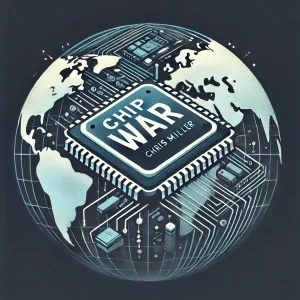Chip War: The Fight for the World’s Most Critical Technology
By Chris Miller
Overview
Chris Miller’s “Chip War” delves into the fascinating and crucial history of silicon chips—semiconductors—that power modern technology. With a narrative that spans decades, this book highlights the key discoveries, inventions, and geopolitical strategies that have shaped the semiconductor industry. From the pioneering days in Silicon Valley to the global dominance of Taiwan’s TSMC, Miller offers a comprehensive account of how these tiny devices became the backbone of modern economies and military powers.
Key Takeaways
- The miniaturization and fabrication of silicon chips are among the most significant engineering feats in history.
- A series of groundbreaking discoveries and inventions have propelled the semiconductor industry forward.
- Starting in the 1960s, US chip companies moved production to Asian countries to capitalize on lower labor costs.
- The US Defense Advanced Research Projects Agency (DARPA) has played a crucial role in supporting chip development for military purposes.
- Taiwan Semiconductor Manufacturing Company (TSMC) is a leading chipmaker, making Taiwan a critical player on the global stage.
- Increasingly, companies design semiconductors while outsourcing production to TSMC and other fabricators.
- China remains heavily dependent on chips and tech products designed in Silicon Valley.
Summary
The Miniaturization of Silicon Chips
The creation of silicon chips, or semiconductors, stands out as a monumental engineering achievement. Fairchild Semiconductor, located in what would become Silicon Valley, introduced the first silicon chip in 1961. This innovation laid the groundwork for modern electronics, evolving from a few transistors to millions within devices like the iPhone. The exponential growth in the number of transistors on a single chip exemplifies the rapid advancements in semiconductor technology.
Semiconductor Industry Development
The semiconductor industry was built on a series of scientific breakthroughs. William Shockley theorized the potential of semiconductors in 1945, leading to the invention of the transistor by John Bardeen and Walter Brattain in 1947. This was followed by Jack Kilby’s development of the integrated circuit in 1958, which allowed multiple transistors to be placed on a single chip, revolutionizing electronics. These foundational innovations set the stage for the explosive growth of the semiconductor industry.
Offshoring Production
By the 1960s, US semiconductor companies began offshoring production to Asian countries to reduce labor costs. Fairchild Semiconductor was the pioneer, setting up facilities in Hong Kong. This trend continued, with countries like Taiwan, South Korea, and Singapore becoming major hubs for chip manufacturing. These regions provided the necessary labor and infrastructure to support the burgeoning industry, further entrenching Asia’s role in global semiconductor production.
DARPA’s Role in Chip Development
DARPA has been instrumental in advancing semiconductor technology for military applications. The agency funded projects that kept the US at the forefront of semiconductor innovation, ensuring a technological edge in defense capabilities. DARPA’s support extended to university programs and private sector initiatives, fostering an environment of rapid technological advancement. The agency’s involvement underscored the strategic importance of maintaining superiority in semiconductor technology.
TSMC’s Rise to Dominance
Taiwan’s strategic investments in the semiconductor industry, particularly through TSMC, have made it a global leader. TSMC’s success, backed by government support, has positioned Taiwan as an indispensable player in the global tech ecosystem. Under the leadership of Morris Chang, TSMC pioneered the foundry model, where it manufactures chips designed by other companies. This approach allowed TSMC to attract a diverse range of clients and cement its position as the world’s leading chip fabricator.
Shift to Outsourced Production
The 1980s saw a shift towards “fabless” companies that design semiconductors but outsource their production to specialized fabricators like TSMC. This model has been particularly beneficial for companies like Apple, which rely on external partners for chip manufacturing. The fabless approach has driven innovation in chip design while leveraging the manufacturing expertise of dedicated foundries. This division of labor has led to significant advancements in semiconductor technology and efficiency.
China’s Technological Dependencies
Despite its efforts to boost domestic production, China remains dependent on advanced chips designed and manufactured by US and allied companies. This dependency poses strategic challenges, as evidenced by the US restrictions on chip exports to Chinese firms like Huawei. China’s ambitious “Made in China 2025” plan aims to reduce this dependency by increasing domestic chip production. However, achieving this goal has proven difficult due to the complexities and capital-intensive nature of semiconductor manufacturing.
Strategic Implications
The geopolitical importance of semiconductors cannot be overstated. The concentration of chip production in Taiwan raises security concerns, especially in light of potential conflicts with China. The US is taking steps to mitigate these risks by encouraging companies like TSMC to set up fabs on American soil. Ensuring a stable and secure supply of semiconductors is critical for national security, economic stability, and technological leadership.
About the Author
Chris Miller teaches international history at Tufts University’s Fletcher School of Law and Diplomacy. He is also the Jeane Kirkpatrick Visiting Fellow at the American Enterprise Institute and Eurasia Director at the Foreign Policy Research Institute. Miller has authored several books, including “We Shall Be Masters” and “Putinomics.”
